Carrot Trial 2014
--Charlene Landreau, MG 2006
Click here for printable (PDF) verison of the report: Carrot Trial 2014 (6MB)
Our Plan
Four varieties of carrot (Daucus carota) were planted in April 2014 at Elkus Test Garden, climate zone 17. The goal of the carrot trial was to document planting technique and irrigation, and to compare growth, yield, and taste of the different varieties. We also wanted to compare the germination rate difference, if any, between seeding with and without a row cover. We provide the resulting information to assist the home gardener both in seed selection and in techniques for growing a successful carrot crop.
A Short History of the Carrot
The wild carrot originated some where around 5000 years ago in the area we now call Afghanistan. These carrots were not orange, but likely purple, with mutations showing up as yellow, white, and even black. (1,2) The carrot migrated throughout the Mediterranean area and also spread eastwards into Asia. It is thought that the present-day orange carrot was developed by the Dutch in the 16th century by crossing various yellow and white mutations of the purple carrot. It is also possible that wild carrot varieties were added into the mix at that time. (1) Wild carrot had a sweet flavor and it is believed that it was used for medicinal purposes by our Neolithic ancestors long before the carrot was ever cultivated. (2) Eventually the plump sweet orange carrot that we know today became the standard. In recent years interest in growing purple, yellow, and white carrots has increased as home gardeners have been re-introduced to these varieties and as new varieties continue to be made available.
Nutrient Information
The anti-oxidant beta-carotene gives orange carrots their color. Beta-carotene is converted in the human intestine into vitamin A. Purple carrots contain another anti-oxidant called anthocyanin, the compound that gives blueberries their “superfood” reputation. Carrots also contain vitamin C, vitamin K, fiber, calcium, potassium, manganese, folate, phosphorus, magnesium, vitamin E, zinc, and iron.(3)
What We Did
April 3, 2014.
Four varieties of carrot were planted in a raised bed at Elkus Test Garden. Yellowbunch Hybrid (65 days), White Satin Hybrid (70 days), Purple Sun Hybrid (90 days), and Napa Hybrid (orange color) (63 days). All seed was purchased from Territorial Seed Company. www.TerritorialSeed.com.
All varieties had “expected days to germination” listed as 6-21 days. Carrots require little nitrogen, so existing soil was not amended.
Irrigation method was ¼” drip line with inline emitters every 6”. The flow rate of each emitter was was approximately .55 GPH. Two rows of seed, one on either side of each drip line, were planted at ¼” depth per packet instructions, covered with soil and gently pressed down. The bed was divided into left and right sides and was planted identically on each side. The left side was then covered with burlap which was held flush to the planted soil with garden staples. The right side was left uncovered. Except for this difference both sides of the bed were treated identically. Our purpose in trying the burlap cover was to test if the germination time or percentage would be different than the uncovered side.
Drip irrigation was set at 15 min everyday to start, delivering an emitter flow rate of approximately .55 GPH, or .125 gallon each day. One week later, April 10, the soil was found to be dry, so irrigation rate was doubled to 30 min per day, delivering .25 gallon per day.
April 3 Seeding Day
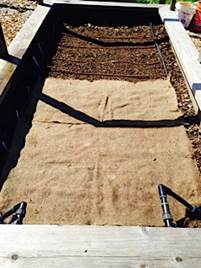
April 17 Germination
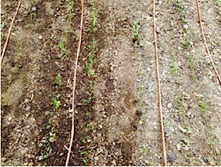
April 17, two weeks after planting:
The soil in burlap-covered side of the bed retained more moisture and showed a higher germination rate at this point. All burlap was carefully removed at this time.
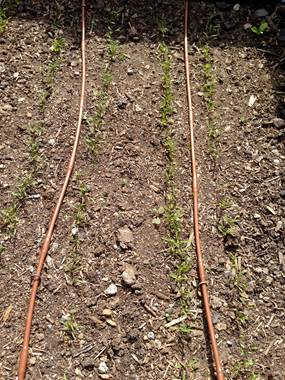
April 24
Three weeks after planting, the non-burlap covered side had caught up with the covered rows. Although the covered rows germinated and emerged more quickly, in the end it made no difference to over-all germination rate. Carrot seedlings were thinned on a weekly basis as needed. Irrigation was left unchanged.
May 8
Germination and height of both sides is equal.
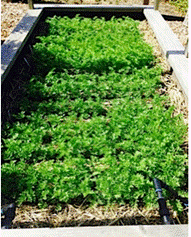
June 5
Baby Carrots from Thinning Yum.
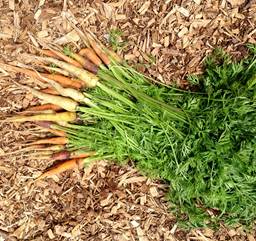
June 18 75 days after seeding
Harvest of all varieties except Purple Sun. Both sides of our bed gave similar yield: approximately 6 lbs. of each carrot variety. We delayed the harvest of Purple Sun because they had not reach the desired size.
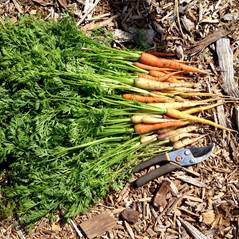
Glazed Carrots recipe below
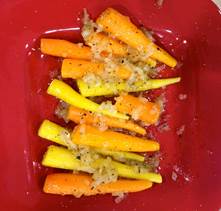
July 19 105 days after seeding
Harvest of Purple Sun variety. Left photo taken immediately before harvest. Yield was again the same on both sides of the bed; approximately 6 lbs.
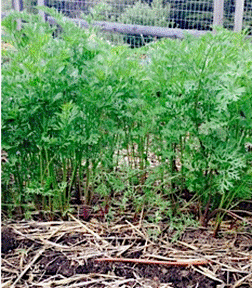
Glazed Carrots recipe below
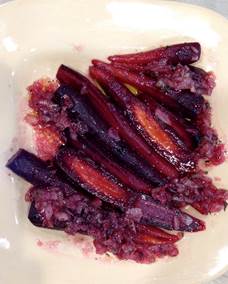
Results
Although soil moisture was greater and seedling emergence was quicker for the side of the bed which we covered with burlap, the end result of germination rate and size at harvest showed no difference. We can’t recommend a row cover as providing any advantage, based on our results.
All varieties took slightly longer (10 days) than stated on their packet to reach maturity.
Carrots did well with an irrigation rate of approximately .25 gallons per emitter day using inline emitter tubing with emitters every 6”.
Yield was terrific. All varieties yielded approximately 12 lbs of carrots from one seed packet.
Taste
Purple Sun
Definitely a favorite, with intense carrot taste and a gorgeous color even after cooking. The interior showed a slightly lighter orange hue than the outside deep purple. 6-8 inch root.
Napa Hybrid
A delicious orange carrot. A Nantes variety with sweet crunch and even sweeter after cooking. 7-8 inch root.
Yellowbunch Hybrid
A butter-yellow exterior. Very pretty when paired with orange or purple on the plate. Less sweet, with a more earthy flavor than a standard orange carrot. Cooking brought out the sweeter side. Not our favorite for raw eating. 6-8 inch root.
White Satin Hybrid
We’re heading toward parsnip territory here. Definitely lacking in carrot-y sweetness if eaten raw. Tender and pleasant when cooked, but very mild. Less color seems to correlate with less flavor. We would probably opt for a sweeter variety next time. 6-8 inch root.
Conclusion
Carrots are relatively easy to grow, though slow to germinate and emerge. They do well without any added nitrogen to the soil. Carrots require a consistent and moderate amount of water. If you are an impatient gardener you might prefer to cover your seeded rows with burlap or other row cover to hasten emergence, but that may not make any difference in yield or days-to-harvest. It did not for us. Taste varies based on color, and there are many new color varieties available to try. A carrot crop will reward the home gardener with a versatile vegetable which is delicious raw, cooked, hot, or cold.
Glazed Carrots Recipe
serve hot or cold
Ingredients
1 pound carrots, peeled if desire, tops removed, cut into equal pieces.
Salt
2 TB sherry vinegar or balsamic vinegar
2 TB honey
2 TB Extra Virgin Olive oil
1 Medium shallot or 2 TB sweet onion, finely diced.
½ -1 tsp fresh thyme or oregano, finely chopped. May use dry herbs.
Black pepper.
Preparation
Place carrots in covered pan with water halfway up the sides of the carrots. Salt well. Bring to a boil and simmer until carrots are barely cooked through. Discard the water.
Add remaining ingredients to the pan and cook about 2 minutes to glazed the carrots and cook the shallot/onion. Serve immediately, or at room temperature, or cold from the fridge.
References
1. http://www.todayifoundout.com/index.php/2010/04/carrots-used-to-be-purple-before-the-17th-century/
2. http://www.carrotmuseum.co.uk/history1.html
Thank You to Master Gardeners Janet Didur and Michael Pettinari
